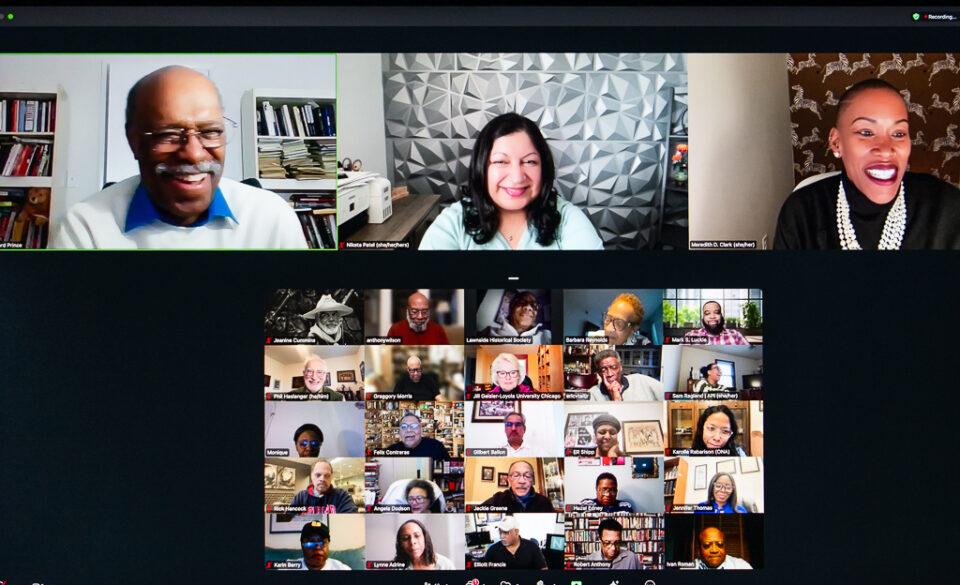If Journos Can’t Beat Social Media, Join In. Here’s How
All photos from Journal-isms Roundtable, including homepage photo, by Jeanine L. Cummins
Support Journal-ismsDonations are tax-deductible.
In New Orleans, “Porch Poppin'” features “two members of the community — they’re not what you would consider influencers per se, they probably have a few hundred or maybe a thousand followers on social media, but they’re two guys that really are known in the community and they basically take all of Verite’s reporting and they turn it into 60 second digest for TikTok,” said Adriana Lacy. They are EJ Johnson, left, and DC Paul. Verite News, which produces the project, describes it as a “daring undertaking to use the power of journalism to expose and dismantle . . . inequities. We will be the voice for the disenfranchised. Sixty-four percent of New Orleans is Black, and we will give them the information they need to flourish and a voice to make changes . . .” (Credit: YouTube)
If Journos Can’t Beat Social Media, Join In. Here’s How
Does it really all come down to “the love language of coffee?”
That’s the phrase used by Toriano Porter (pictured, below), editorial writer at the Kansas City Star, to describe how he gets closer to his readers. It’s Porter’s way of becoming a “social influncer,” a term, it turns out, that has many meanings at a time when social media is competing with traditional journalists for the public’s loyalties.
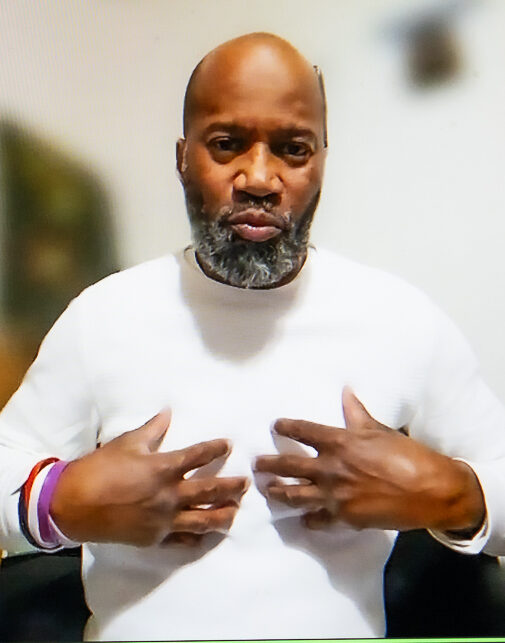 “One thing that I’ve learned is if people are going to buy in to you as a news source, they’re going to subscribe to your paper. They have to believe in you. They have to trust you. You have to establish rapport with them. So what I’m trying to do is use coffee as a universal language,” Porter told the Journal-isms Roundtable.
“One thing that I’ve learned is if people are going to buy in to you as a news source, they’re going to subscribe to your paper. They have to believe in you. They have to trust you. You have to establish rapport with them. So what I’m trying to do is use coffee as a universal language,” Porter told the Journal-isms Roundtable.
“So a lot of my social media posts have to do with coffee, I go to different coffee shops because I work remotely most of the time.
“And I’m just — I’m connected with people through the love language of coffee, right? . . .
“It’s a universal love language. I’ve sat down. I’m an opinion writer, guys, for the Kansas City Star’s editorial board.
“And I’ve sat down with people who did not agree with my columns and reached out to me via email and . . . discovered that we have way more things in common than we do not in common. But my point in all that is I’ve used that on every social media channel that I have, whether you’re talking about LinkedIn, Instagram, X, Twitter, whatever it is called these days. I’m on everything but Snapchat.
“I don’t do no dance, no TikTok, though. Don’t do no dancing. But I’m a serious newsman.
“But I’ve used the social media tools to draw people into buying in to me as a trusted source.
“And when I want to promote my stories or promote my editorials or columns, you know, I usually, I don’t have to keep begging for people to subscribe. It’s just part of the branding now.”
Journalists know this: “The journalism and media industry in 2025 is undergoing a dramatic transformation, driven by rapid technological advancements, shifting audience behaviors, and the economic realities of a digital-first world,” as career consultant Jennie Johnson said in a message shortly before the gathering, which took place via Zoom on March 24.
Fifty-two people were on the call, another 86 had watched on Facebook by the next day, and as of May 15, some 115 took in the YouTube version. Editor & Publisher alerted its readers to what we had planned.
Johnson’s message continued, “Traditional newsrooms, long the backbone of the profession, are shrinking under the weight of declining ad revenues and competition from digital platforms. In just the first quarter of 2025, over 900 journalism jobs were cut across the U.K. and U.S., adding to the staggering 15,000 layoffs reported in 2024. These sobering statistics reflect a broader trend — one in which legacy media outlets struggle to adapt to an industry increasingly shaped by artificial intelligence, independent content creators, and niche digital platforms.”
Some might also know this:
“Black, Hispanic and Asian American adults are more likely than white adults to put a great or moderate amount of confidence in election information they receive from social media (38%, 32% and 30% vs. 19%),” the American Press Institute reported last year.
The Roundtable asked the question, “How can journalists survive and thrive in this new environment of social media and social media influencers? “
The panelists were:
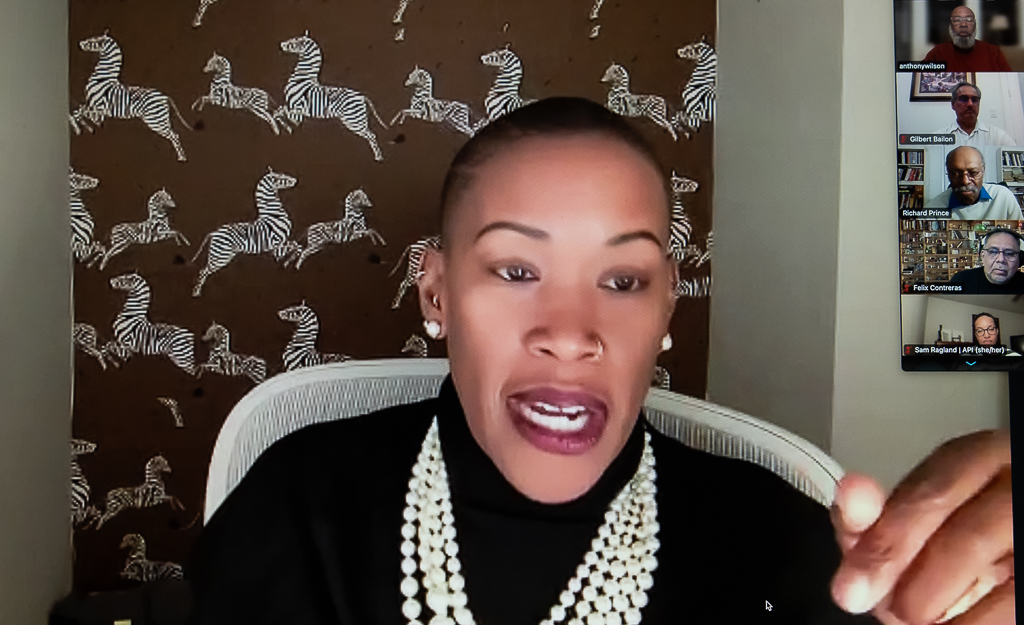 Meredith D. Clark, Ph.D,(pictured), researcher, journalist, teacher, media consultant and author of “We Tried to Tell Y’all: Black Twitter and the Rise of Digital Counternarratives.” Among other points, Clark emphasized the need for all journalists to be on social media platforms and addressed the issue of online harassment. “I can remember when I wrote a weekly column for the Tallahassee Democrat,” she said. “I can guarantee that on Monday — my column ran on a Friday. On Monday, there was going to be a guy calling me a nigger every single Monday, I knew he would be there. And so what’s different is that I was the only person who had to deal with that when I was working for legacy media. Now with social networking platforms, more people can see it.”
Meredith D. Clark, Ph.D,(pictured), researcher, journalist, teacher, media consultant and author of “We Tried to Tell Y’all: Black Twitter and the Rise of Digital Counternarratives.” Among other points, Clark emphasized the need for all journalists to be on social media platforms and addressed the issue of online harassment. “I can remember when I wrote a weekly column for the Tallahassee Democrat,” she said. “I can guarantee that on Monday — my column ran on a Friday. On Monday, there was going to be a guy calling me a nigger every single Monday, I knew he would be there. And so what’s different is that I was the only person who had to deal with that when I was working for legacy media. Now with social networking platforms, more people can see it.”
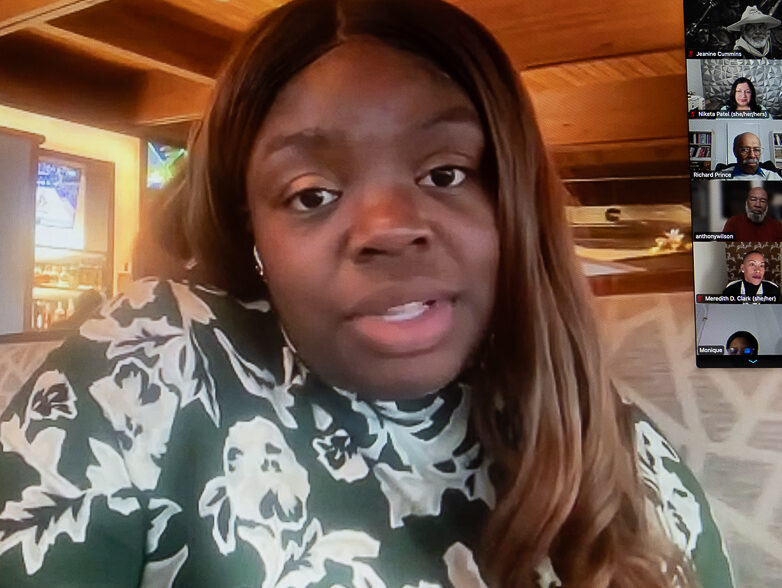 Adriana Lacy (pictured), who has spent more than a decade working in audience engagement, including working at The New York Times and Axios, and now heads her own consulting agency to help newsrooms adopt the best practices of “creator journalism.” She urged attendees to think broadly about the term “social influencer” and recommended that journalists also think local when they consider the term. In particular, she mentioned “Porch Poppin” from Verite News in New Orleans (see video above).
Adriana Lacy (pictured), who has spent more than a decade working in audience engagement, including working at The New York Times and Axios, and now heads her own consulting agency to help newsrooms adopt the best practices of “creator journalism.” She urged attendees to think broadly about the term “social influencer” and recommended that journalists also think local when they consider the term. In particular, she mentioned “Porch Poppin” from Verite News in New Orleans (see video above).
-
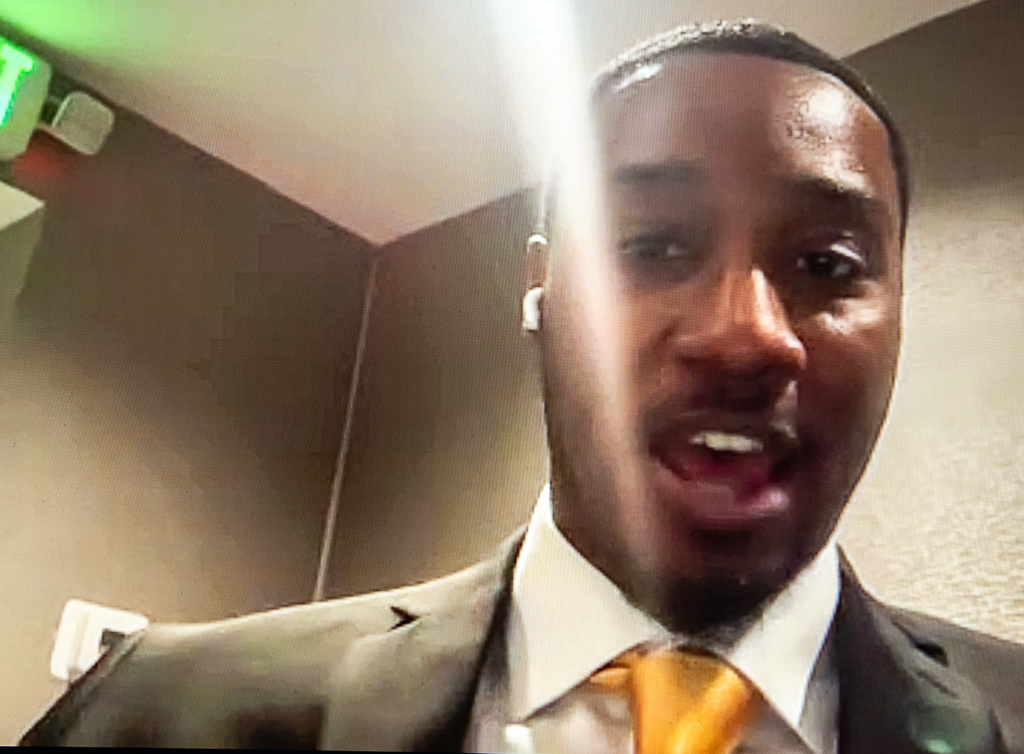 Philip Lewis (pictured), deputy editor at HuffPost, news aggregator and president of the Washington Association of Black Journalists, who was called “The Anderson Cooper of Black Twitter” last year by Wired magazine.
Philip Lewis (pictured), deputy editor at HuffPost, news aggregator and president of the Washington Association of Black Journalists, who was called “The Anderson Cooper of Black Twitter” last year by Wired magazine.
Just before the Roundtable, Lewis, whose “What I’m Reading” attracts more than 35,000 subscribers, was named one of “Tomorrow’s News Trailblazers.” by Editor & Publisher magazine. Lewis urged journalists to narrow their focus to niche audiences — older Americans are a neglected demographic — and alerted attendees to the growing influence of podcasts,
“There are situations where news influencers and journalists can actually work together,” Lewis said. “And so for WABJ, I’ve been trying to reach out to news influencers that are in D.C. who have these large platforms and maybe there are ways that we can all work together. Maybe we can teach them about some journalism techniques. Maybe they can teach us about brand building. So trying to figure out how we can come together and work together is something that we’re trying to do over at WABJ.”
Of his online newsletter, Lewis said the thing “that I find fun . . . the biggest thing is probably just the satisfaction of knowing you are your editor. You are the person that makes the judgment call for the story that you want to write without necessarily any oversight, which I guess could be a good or bad thing.”
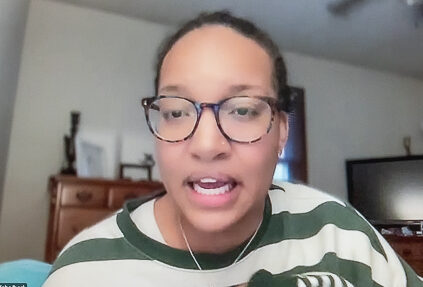 Samantha Ragland (pictured), vice president, journalism programs at the American Press Institute; journalist, educator and digital strategist. Ragland was quoted at length in Editor & Publisher, saying, ”Traditional outlets can learn from influencers’ audience engagement strategies, while creators can benefit from established journalistic practices.“ She offered suggestions for retaining journalists in light of the competition from web outlets, based on her experiences with her former employer, the Palm Beach (Fla.) Post, and expanded on the concept of finding “trusted messengers” who give the news organization credibility.
Samantha Ragland (pictured), vice president, journalism programs at the American Press Institute; journalist, educator and digital strategist. Ragland was quoted at length in Editor & Publisher, saying, ”Traditional outlets can learn from influencers’ audience engagement strategies, while creators can benefit from established journalistic practices.“ She offered suggestions for retaining journalists in light of the competition from web outlets, based on her experiences with her former employer, the Palm Beach (Fla.) Post, and expanded on the concept of finding “trusted messengers” who give the news organization credibility.
Adding to the question of online harassment, Ragland said “the online space is scary. It’s been scary for a long time. The trolls are louder than anyone, right? And so there’s a lot that I think could change across the cultures of our newsroom to further uplift and protect our journalists. She recommended that journalists seek support from PEN America, the International Women’s Media Foundation and the Dart Center for Journalism & Trauma.
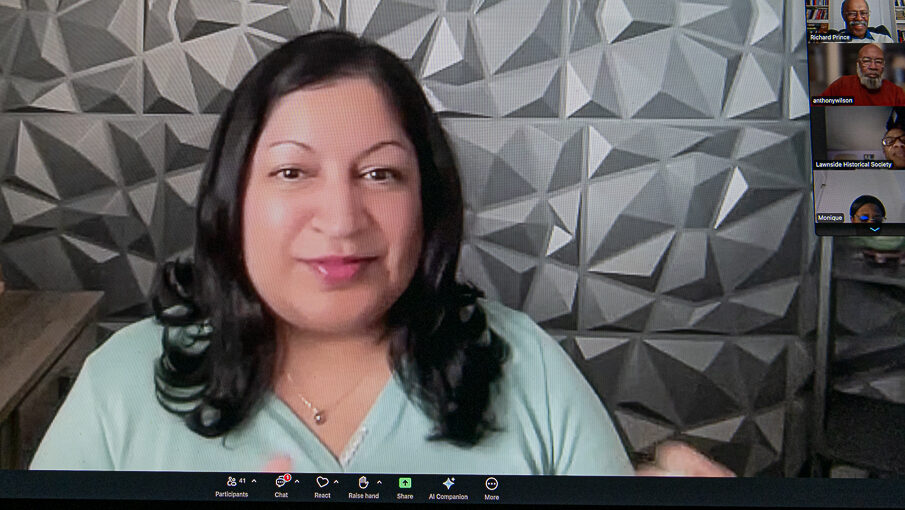 The Roundtable also toasted Niketa Patel (pictured), newly named executive director of the Online News Association.
The Roundtable also toasted Niketa Patel (pictured), newly named executive director of the Online News Association.
“We have big plans for ONA,” she said. “I’m going to obviously be easing into the role very slowly, but making sure that we have the best programs out there, that we’re really thinking about challenges, but turning challenges that we’re facing in this moment, right? . . . AI, you know, there are a lot of different headwinds in terms of the business side of things. . . .
“I’m all about turning challenges into opportunities. And so that is kind of my mindset coming into this role. And I think that as an industry, we have so many opportunities to make sure that journalists are seen and heard, protected and cared for.”
Perhaps the message from the session with the most resonance was the reassurance that yes, succeeding on social media is not rocket science.
Lacy said, “The biggest thing to keep in mind is just to understand that it doesn’t need to be perfect. I’ve been working with a lot of people who are like, ‘I want to do this, but I’m so nervous. Like, what if it doesn’t work?’
“I was actually talking with a creator; she has probably 5 million followers across all of her platforms. And she said, ‘you know, when I started, my videos were getting five views and it took years to build this’. So I think just starting it, experimenting, seeing what works is something that works really well. You don’t need to have super-slick graphics and super-high-tech video to do this. I think just talking about what’s going on, being honest, being authentic, sharing verified information is really all you need to get started.”
Added Ragland:
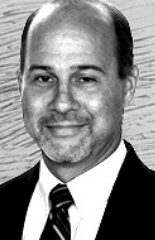 “We had an award-winning financial reporter who specialized in like insurance, like insurance claims, insurance fraud. I’m in South Florida, right? Charles Elmore (pictured) was amazing. And like when we were still programming Snapchat, he became an influencer, very much so for our Snapchat account. We didn’t have a lot of people on there. It was maybe 24. 25, 2,700 folks.
“We had an award-winning financial reporter who specialized in like insurance, like insurance claims, insurance fraud. I’m in South Florida, right? Charles Elmore (pictured) was amazing. And like when we were still programming Snapchat, he became an influencer, very much so for our Snapchat account. We didn’t have a lot of people on there. It was maybe 24. 25, 2,700 folks.
“But in the midst of all of his print reporting that he was doing, he partnered with our social media reporter to storyboard out and create a multi-part series. We featured his financial consulting to our Snapchat account. He got people out of debt. He helped them learn why Verizon wasn’t the best cell phone for them. He did all kinds of stuff. And when we would ask people on our Snapchat account, what programming do you want more of from the Palm Beach Post? People wanted Charles, y’all. He won like innovator of the year for this special series that we did.
“And the reason why is because he was like this dad that everybody could trust, right? And he was teaching them things and he was storyboarding all of these really awesome — he was using every level of intricacy within Snapchat from the filters and the different, just all kinds of stuff, right? And he never downloaded the app, by the way. He worked directly with the social media reporter on my team. And so . . . if you are in a local newsroom or in any newsroom, and you feel that you have experience worth cultivating and sharing with a larger audience, then this really is a great time to do that because any level of information can be translated if you are just willing to work with the right person and get in front of the camera. . . .
In February, the Pew Research Center hosted a virtual panel event about influencers as a source of information about current events and civic issues in the U.S., which included Makena Kelly, senior politics writer, Wired; Mosheh Oinounou, founder, Mo News; Raven Schwam-Curtis, content creator and keynote speaker) and Galen Stocking, senior computational social scientist, Pew Research Center). (Credit: YouTube)
“And what can that look like and what can that feel like? Well, it can actually look and feel very, very good if you can figure out your own office-style way of doing this type of reporting and sharing; office-style in that anybody who’s doing really strong influencer-style or creator-style journalism knows how to break the fourth wall. They know how to make it feel like you’re not talking to a phone and you’re not being listened to through a device, right? And I would imagine that most people in this room, if given a chance and a couple of opportunities to make mistakes within the comfort of their own newsroom, you all would be pretty exceptional.”
Social media themselves are changing. Lewis said he has switched to email because people are turning away from social media “because of all the changes and the things that have happened.
“So that’s why I created my own sub tag. I want people’s emails. You might not even be able to see my tweets anymore because of Elon Musk, right? So I created it because I want people, I want that direct connection with people’s emails and I can just cut out the social media middleman, I guess you could say.
Clark added that “the online space is scary. It’s been scary for a long time. The trolls are louder than anyone, right? And so there’s a lot that I think could change across the cultures of our newsroom to further uplift and protect our journalists.”
Attendees said they were pleased with the discussion.
“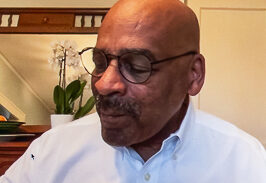 “Each of the panelists offered excellent insights into how we as journalists can navigate our digital presence,” said Gary Lee (pictured), executive editor of the Tulsa (Okla.) Local News Initiative and The Oklahoma Eagle.
“Each of the panelists offered excellent insights into how we as journalists can navigate our digital presence,” said Gary Lee (pictured), executive editor of the Tulsa (Okla.) Local News Initiative and The Oklahoma Eagle.
Karolle Rabarison, director of communications of the Online News Association, said, “I appreciated that it was a level-headed look at both the opportunities and challenges. There were practical examples, including guidance on vetting influencers for newsrooms to partner with, and a good discussion segment on thriving vs. surviving and the inherent uncertainty of working with fleeting platforms and algorithms.”
Photographer Jeanine Cummins messaged the next day, “The fact that you have Black journalists and others from throughout the country is more than any network news could offer. I like hearing the different perspectives. I am not a big user of social media. I am on Instagram for my photography and I listen to podcasts. Last night’s Roundtable talked about the importance of all parts of social media whether it is X (Twitter), FB, IG, or vetted influencers. If used correctly, it provides an option to receive information rather than misinformation and disinformation. This can be true for photojournalists as well, especially with AI in the mix.”
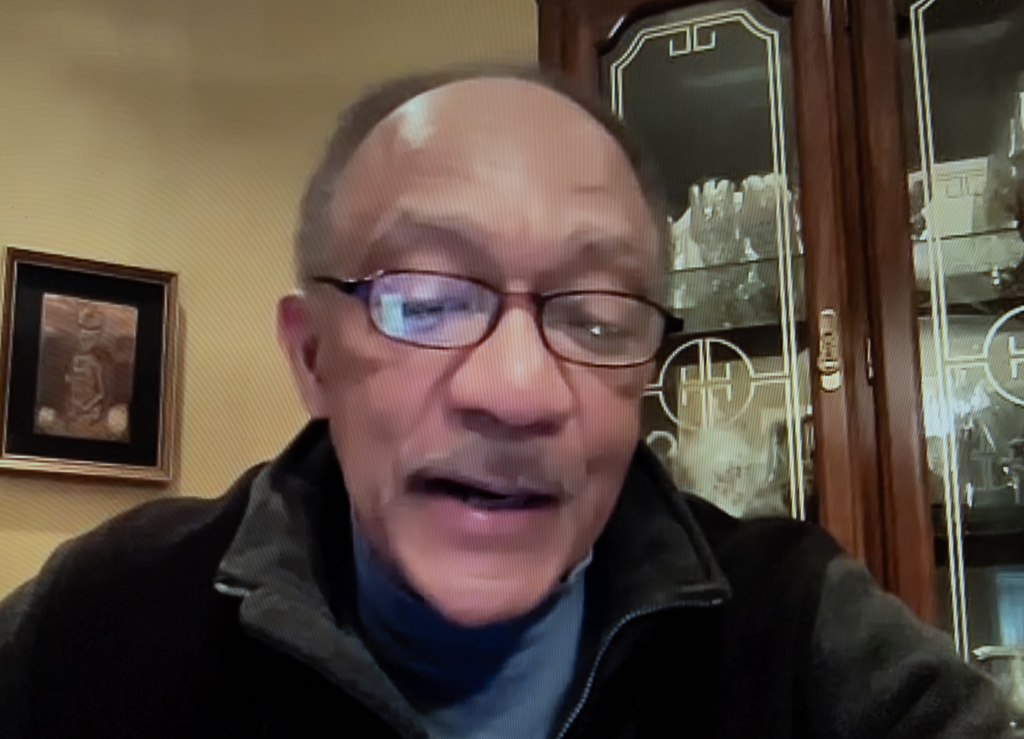 Jackie Greene (pictured), producer of the Zoom, told the group, “I also agree . . . about the term influencer. When you first hear that. It has a different connotation here. But how it was explained tonight. It’s changed my whole thinking about when I hear that word now how I’ll think about it.”
Jackie Greene (pictured), producer of the Zoom, told the group, “I also agree . . . about the term influencer. When you first hear that. It has a different connotation here. But how it was explained tonight. It’s changed my whole thinking about when I hear that word now how I’ll think about it.”
A student at Morgan State University messaged that she found most insightful “the part [where] Adriana mentioned one does not need to have it all figured out from scratch, especially as a newbie to social media and in fact influencer journalism and or marketing. More like, it’s okay to take it one step at a time, discover your niche, build your fan base and all.”
Further reading:
- Camille Bromley, Columbia Journalism Review: Q&A: Bloomberg’s Davey Alba and Leon Yin on the New Political Influence of Podcasts (Feb. 19)
- Feedspot: Top 100 Black Influencers in 2025 (Feb. 22)
- Feedspot: Top 80 Asian American Influencers in 2025 (Feb. 22)
- Feedspot: Top 100 Indigenous Influencers in 2025 (Feb. 22)
- Aisha Frazier and Jessica Mendoza, ABC News: Hispanic Influencers reflect on their impact, untapped potential (Sept. 16, 2023)
- Katherine Fung, Newsweek: Why Is Everyone Suddenly on Substack?
- Kayla Gogarty, Media Matters for America: The right dominates the online media ecosystem, seeping into sports, comedy, and other supposedly nonpolitical spaces (March 14)
- Drew Harwell and Sarah Ellison, Washington Post: Inside the White House’s new media strategy to promote Trump as ‘KING’
- Samantha Hooley, National Press Foundation: Social First: How Journalists Can Win Gen Z Audiences (Feb. 21, updated March 6)
- Journal-isms: A Plea: Save Us From Social Media Propaganda (Dec. 16, 2024)
- Journal-isms: Increasingly, More Put Their Trust in Gossip (Oct. 21, 2024)
- Journal-isms: People of Color Too Trusting of Social Media? (May 5, 2024)
- Betsy Klein, CNN: Influencers get prime DNC access as part of Harris’ campaign strategy (Aug. 22, 2024)
- Charlotte Klein, New York: The New Substack Universe (March 20)
- Jake Lahut, Columbia Journalism Review: The New Kids in the Room (Feb. 19)
- Cynthia Littleton, Variety: Roland S. Martin Enlists Social Media Political Sensation Knowa De Baraso for Black Star Network (Aug. 31, 2024)
- Cynthia Littleton, Variety: ‘This Is Hope 2.0′: Roland S. Martin on the DNC’s Embrace of Alternative News Outlets, Kamala Harris’ Moment and Fighting Misinformation (Aug. 20, 2024)
- National Press Foundation, YouTube: News Influencer Kelsey Russell on What Journalists Can Learn from Content Creators (video) (Feb. 25)
- Jason Parham, Wired: The Anderson Cooper of Black Twitter Believes Journalism Can Survive Influencers (June 14, 2024)
- Pew Research Center: Social Media
- Sarah Scire, Nieman Lab: The Washington Post’s TikTok guy will publish a Post-produced news series on his personal channel (Feb. 27)
- SocialBook: Top 20 African American Instagram Influencers to Follow in 2025 (Oct. 8, 2024)
- Todd Spangler, Variety: YouTube at 20: How the Video Colossus Launched the Creator Economy and Turned From Hollywood Foe to Friend
- Diane Sylvester, Editor & Publisher Magazine: The new ‘army’ of journalists: Creators and influencers impact our industry
- Hanaa’ Tameez, Nieman Lab: Noosphere aims to create a subscription bundle for your favorite journalists’ content
- Max Tani, Semafor: House Democrats organize digital creators to counter Trump’s speech
- Max Tani, Semafor: Reporters launch new TikTok-like news platform (Feb. 23)
- Max Tani, Semafor: Democrats, influencers huddle for a new new media strategy (Feb. 16)
- Jessica Testa, New York Times: A Political Reporter Takes Her Scoops to YouTube (March 9)
- Lamar West, BuzzFeed: 19 Latine Creators That Are Killing The Game Right Now And Deserve Your Follow (Oct. 9, 2024)
- Ariel Zirulnick, American Press Institute: Develop your influencer strategy A step-by-step process to demystify influencer collaborations and enhance community outreach
- Rob Tornoe, Editor & Publisher: SNARF: Killing social media? News organizations must decide if and how to use social media in their pursuit of audience (March 14)
Follow Richard Prince on Twitter @princeeditor
Richard Prince’s Journal-isms originates from Washington. It began in print before most of us knew what the internet was, and it would like to be referred to as a “column.” Any views expressed in the column are those of the person or organization quoted and not those of any other entity. Send tips, comments and concerns to Richard Prince at journal-isms+owner@
View previous columns (after Feb. 13, 2016).
View previous columns (before Feb. 13, 2016)
- Diversity’s Greatest Hits, 2018 (Jan. 4, 2019)
- Book Notes: Is Taking a Knee Really All That? (Dec. 20, 2018)
- Book Notes: Challenging ’45’ and Proudly Telling the Story (Dec. 18, 2018)
- Book Notes: Get Down With the Legends! (Dec. 11, 2018)
- Journalist Richard Prince w/Joe Madison (Sirius XM, April 18, 2018) (podcast)
- Richard Prince (journalist) (Wikipedia entry)
- February 2018 Podcast: Richard “Dick” Prince on the need for newsroom diversity (Gabriel Greschler, Student Press Law Center, Feb. 26, 2018)
- An advocate for diversity in the media is still pressing for representation, (Courtland Milloy, Washington Post, Nov. 28, 2017)
- Morgan Global Journalism Review: Journal-isms Journeys On (Aug. 31, 2017)
- Journal-isms’ Richard Prince Wants Your Ideas (FishbowlDC, Feb. 26, 2016)
-
Richard Prince with Charlayne Hunter-Gault, “PBS NewsHour,” “What stagnant diversity means for America’s newsrooms” (Dec. 15, 2015)
- Book Notes: Journalists Follow Their Passions
- Book Notes: Journalists Who Rocked Their World

